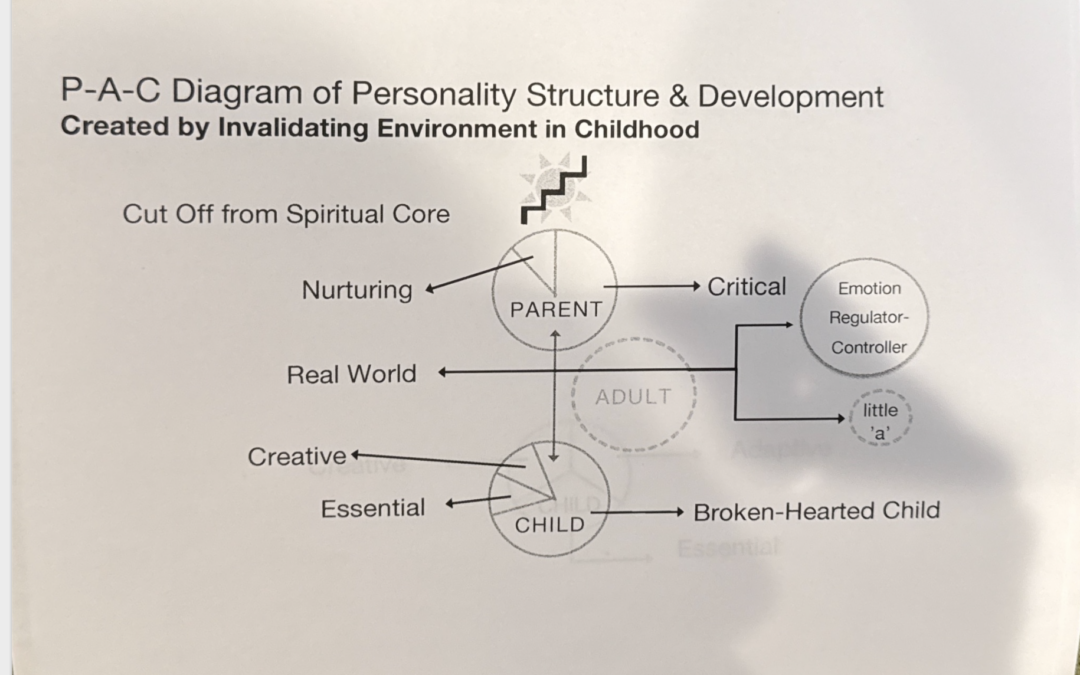Attachment trauma can significantly impact the development of personality, particularly when an individual is raised in an invalidating environment. I recently participated in an advanced training with Ann E. Potter and Debra Wesselmann who wrote “EMDR and Attachment-Focused Trauma Therapy for Adults, Reclaiming Authentic Self and Healthy Attachments.” I am now incorporating the concepts of their training into my work with clients.
Using the Parent-Adult-Child (P-A-C) diagrams, we can visualize how such environments shape our inner selves and affect our emotional and psychological growth.
The Impact of Invalidating Environments
As I often remind my clients, it’s essential to understand that the parts of oneself that may feel under or overdeveloped are not a personal failing; rather, they are a product of one’s experiences. It’s crucial to frame these discussions with compassion: “It’s not your fault that you have parts that are under- or overdeveloped. It’s about what happened to you during your development.” This acknowledgment sets the stage for understanding how personality is influenced in a nonoptimal environment.
The P-A-C Diagrams Explained
The P-A-C diagrams help illustrate how a child’s personality develops in the context of their environment. In an invalidating context, we begin with the core of our being—our Essential, Creative, and Adaptive aspects, which connect us to a Spiritual Essence of goodness.
- Inner Child/Adolescent: At the top of the diagram, we see the inner Child/Adolescent part of the Self, characterized by its connection to foundational goodness and creativity. This part is inherently positive but can become compromised due to the environment.
- Nurturing Parent: In a nurturing environment, the Nurturing Parent provides a strong foundation of support and care. However, in an invalidating environment, this aspect is often underdeveloped, leading to a fragmented sense of self. The nurturing messages received are scarce, conditional, or often absent entirely.
- Protective Parent vs. Critical Parent: The Protective Parent, which is intended to shield us from harm, can become distorted in an invalidating environment, morphing into a Critical Parent. This part of the Self delivers negative, damaging messages: “You’re bad,” “You can’t succeed,” “You don’t deserve happiness,” or “The world is dangerous.” Instead of providing protection, the Critical Parent further alienates us from our spiritual core and reinforces negative cognitions.
The Cycle of Negative Cognitions
The internalized messages from the Critical Parent deeply affect our self-image and the way we navigate life. In fact, they can lead to a cycle of harmful beliefs that persist into adulthood. As we internalize these messages, our Creative and Essential aspects of the Child/Adolescent part weaken, depriving us of curiosity, spontaneity, and joy in our adult lives.
For instance, clients might try to compensate for these negative cognitions in various ways:
Striving for Perfection: Many clients pursue success obsessively, hoping to prove their worth. They push themselves to achieve and win, longing for validation.
Avoidance or Self-Sabotage: Others might give up completely and act in ways that reinforce the Critical Parent’s narrative—demonstrating their “badness” through destructive behaviors that only serve to confirm their negative beliefs.
The Role of the Competent Adult
As we progress into adulthood, the development of the Competent Adult part of the Self becomes crucial. In those raised in an invalidating environment, this part may be weakened or overdeveloped:
Underdeveloped Competent Adult: If this part is underdeveloped, it struggles to mediate between the inner Child and the Critical Parent, leading to impulsive actions or emotional outbursts.
Overdeveloped Competent Adult: Conversely, if overdeveloped, it can manifest as an Emotion Controller-Regulator, focusing solely on suppressing emotions rather than experiencing them, which can stifle connection and intimacy in relationships.
Moving Towards Healing
By recognizing these dynamics, we can begin the work of integrating these parts of ourselves. It is essential for clients to visualize their internal structure and relationship between the Parent, Adult, and Child aspects.
- Self-Reflection: I often invite clients to reflect on how they relate to these concepts: “Help me understand which aspects of this discussion resonate with your experiences growing up. What do you notice about your reactions as an adult?”
- Personal P-A-C Diagram: We may then transition to a practical exercise where clients illustrate their own P-A-C diagram. I encourage them to express what their inner Self looks like, how their parts interact, and where they may feel disconnected: “I’d like to understand what your drawing or representation tells us about you.”
Cultivating Understanding
Understanding how personality development is impacted by attachment trauma is a vital step toward healing. The P-A-C diagrams serve as a tool for visualization, helping individuals see how their childhood environment has influenced their adult selves. Acknowledging these parts allows for compassion, healing, and ultimately, the integration of a more authentic sense of Self. Through therapy, clients can learn to nurture their inner Child, challenge their Critical Parent, and cultivate a healthier and more cohesive internal narrative.
Final Thoughts
The journey of self-discovery and healing is multifaceted and often challenging, especially for those who have faced the trials of an invalidating upbringing. However, by exploring these inner dynamics through the lens of attachment theory and utilizing tools such as the P-A-C diagrams, individuals can begin to untangle the complexities of their emotions and beliefs. This process not only aids in personal growth but also fosters stronger, healthier relationships with others.
Healing from attachment trauma is not merely about addressing past wounds; it’s about reclaiming one’s narrative and allowing the essence of creativity, joy, and the inner Child to flourish once again. Through this transformative process, individuals can build a more cohesive, empowered, and fulfilling adult life.

